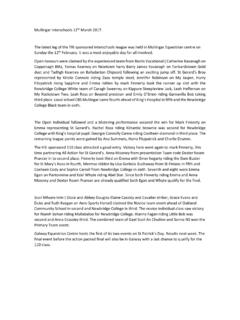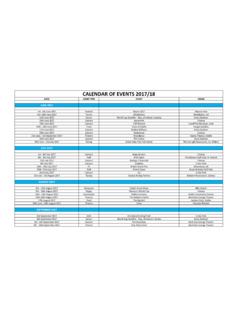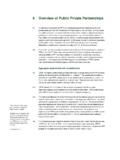Transcription of Government publishes the final ... - Galway County …
1 Government publishes the final Report of the Expert Technical Group on the Options and Appropriate Courses of Action available at the Tuam Mother and Baby Home. 12 December 2017. Frequently Asked Questions: 1. What has the Minister published today? The Minister for Children and Youth Affairs has published the final Report of the Expert Technical Group (ETG) entitled, Options and Appropriate Courses of Action available to Government at the site of the former Mother and Baby Home, Tuam, Co. Galway . The Report is available on the website of the Department of Children and Youth Affairs ( ). 2. What does the report say? In the Report, the ETG identifies five possible options for responding to the discovery of infant remains at this site. These options have regard to internationally accepted best practice and will help to make more informed decisions about the future of the site. The technical options are presented from the perspective of their requirements, outcomes, estimated timelines and costs and are outlined in detail at Appendix 1.
2 In brief these involve: 1) Memorialisation, with no further investigative work involved. The site would be returned to its original state and managed as a memorial. (Memorialisation could also be combined with any of the options below). 2) Exhuming of known human remains and re-interring elsewhere, but with no further forensic analysis. 3) Forensic excavation and recovery of known human remains. This would include use of an approach known as humanitarian forensic action, with the recovery and analysis of all remains from the identified chambers. 4) Forensic excavation and recovery, with further evaluation/excavation of other areas of potential interest. It would include an extensive programme of non-intrusive investigative work, which would then inform decisions as to what further areas of the site (if any) might contain human remains. 5) Forensic examination of the total available area, with full examination of the memorial garden, playground, car park area as formerly occupied by the Home.
3 It would be the most intrusive option available, aimed at exhausting all potential for further relevant human remains. It would however exclude the built private areas, including the house and gardens subsequently built on the site. The Minister is open to considering these courses of action. However, she strongly believes that consultation is a critical first step in advance of any further decisions, using the important practical information provided by the ETG's report as a support to the local community and other interested parties in forming informed views about the different options. 3. What were the main issues that the ETG examined in the Second Report? The nature and ownership of the Memorial site The history of the Tuam site Geophysical Survey of the Tuam site Current knowledge of the Subterranean Structure containing the interned remains National and International Sites Comparable to the Tuam site Humanitarian Forensic Action The Use of DNA for Individual Identification Memorialisation and Transitional Justice Role of the Coroner of North Galway 4.
4 What technical challenges are identified in the Report? The report finds that the particular circumstances of the situation in Tuam are unprecedented from a technical perspective. No directly comparable cases either nationally or internationally were identified by the experts. These complicating factors include the significant quantities of juvenile remains; the fact that the remains have become commingled' or inter-mixed over time, making individual identification very difficult; and the problems of accessing the remains because of their position within deep sub- surface chambers. The report emphasises that the complexities of these factors cannot be under- stated and that the outcomes from various options may be more limited than some might expect. The ETG notes that where exhumation is envisaged in some options, it would be considered preferable to sort the mixed or commingled remains into individual remains ( individualisation') to the greatest extent possible, but that this requires a variety of highly specialised techniques from osteology, anthropology and DNA molecular techniques which do not guarantee success.
5 5. What does the Report say about the use of DNA technology? The ETG report cautions that DNA identification is highly complex and that individual identification of remains here is highly unlikely without further significant investigation'. The report makes the following key points in relation to the potential use of DNA testing in Tuam: (i) The need to communicate realistic expectations as to what DNA testing may be able to produce in a complex site such as Tuam. (ii) The impossibility of achieving positive DNA identification of infants and young juveniles without samples from living relatives. Even then, identification will be extremely difficult, and will depend on the quality of the remains recovered. (iii) The quality of samples are less likely to be usable for DNA identification in the case of infants because the best source of DNA can be teeth, including the root, which are not sufficiently formed in humans until the age of 2 years. (iv) The fact that the process of DNA testing can itself destroy the samples, leaving little left to re-inter after the process.
6 While this may be acceptable when dealing with whole skeletons or significant intact portions, it is far less satisfactory when being used to identify individual fragments of commingled remains which are effectively destroyed as they are individualised'. (v) The need for a pilot/feasibility study before any decision is taken to move to a larger programme of DNA testing. Even then, the pilot/samples would give an indication of results only for the selected sample, rather than for the wider site. The extent to which specific questions can be addressed, or the potential application of technologies such as DNA, will need to be considered in the context of the relevant technical and scientific challenges identified in the Report. 6. What happens next? The report is a detailed technical document, which runs to over 250 pages, so it will understandably take some time to absorb and fully process what it tells us. The Government is conscious that this is a very sensitive and difficult matter for many former residents, their families and those living in the vicinity of the site.
7 The Minister wants to ensure that everyone who wishes to contribute to the deliberations on what action should be taken has the opportunity to do so. The Minister wants a consultation process to begin as soon as possible. Galway County Council will facilitate a structured consultation on the basis of the options put forward by the ETG, to determine the views of all interested parties. The Council will report back to the Inter-Departmental Group (IDG) within 3 months of the publication of this report. The IDG will then propose a course of action for consideration by the Government . The Council will make further announcements on this through the media. 7. What oversight arrangements are in place for this project? The IDG, led by the Department of Children and Youth Affairs (DCYA), will provide an oversight role for the whole of Government in terms of strategy and overall approach for the project. The results of the consultation process will be reported back to the IDG within 3 months and the Group will then propose a course of action for consideration by Government .
8 The need for further technical assistance will be considered after the results of the consultation process are known and decisions taken by Government on a specific course of action. This reflects the identified need for an oversight body within the Report. However it is likely that a multi-disciplinary technical group with the necessary expertise in archaeology, anthropology and forensic science will be necessary to implement the detail of whatever option is chose for the site at Tuam. The Minister considers that this issue is best considered after the results of the local consultation process are known, and decisions are taken by Government regarding the implementation phase. 8. What is Galway County Council's involvement with this site? It is the understanding of the ETG that the site is currently in the ownership of Galway County Council. The Council will arrange for a structured consultation with stakeholders, on the basis of the options put forward by the ETG, to determine the views of all interested parties.
9 The Council will lead this process proposed to utilize independent facilitation to effectively engage with all who are affected, whether as former residents of the home, relatives of those who may be buried there, or as local residents who live near the site. The Council will have the continued assistance and support of the Department of Children and Youth Affairs and the IDG and will consider the need for external expertise in the management of a process designed to capture and report feedback on the options and practical implications as set out by the ETG's report. Galway County Council will make further announcements on this process in the coming days. 9. Why was the Expert Technical Group set up? An early focus of the Commission of Investigation's work was to examine the question of burials on the site of the former Bon Secours Mother and Baby Home in Tuam, Co. Galway . Following a series of surveys and test excavations, the Commission confirmed the discovery of juvenile human remains, in significant quantities, in a subsurface chamber on the site of historic sewage system at the former Mother and Baby Home.
10 The Commission announced this discovery in March 2017. In responding to this discovery, Minister Katherine Zappone commissioned an Expert Technical Group (ETG) to outline to Government what options are available to respond in the context of internationally accepted best practise in such cases. 10. Who are the members of the Expert Technical Group? The ETG is a six person team which employed a multidisciplinary approach to the technical issues at the Tuam site including forensic archaeology, forensic anthropology, osteoarchaeology, excavation, remote sensing, DNA Analysis and the Irish medico legal perspective. The members of the ETG are: Niamh McCullagh, Forensic Archeologist, Hugh Tuller, Forensic Anthropologist, Tim Clayton, Forensic Scientist, Linda Lynch, Expert in Juvenile Osteoarchaeology, Aidan Harte, Expert in Irish Archaeology and remote sensing, Brian Farrell, Coronial Expert. 11. What estimates of costs has the ETG included in its report? The costs of the different options as estimated by the ETG are summarised in Appendix 1.







